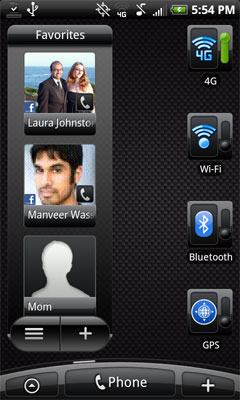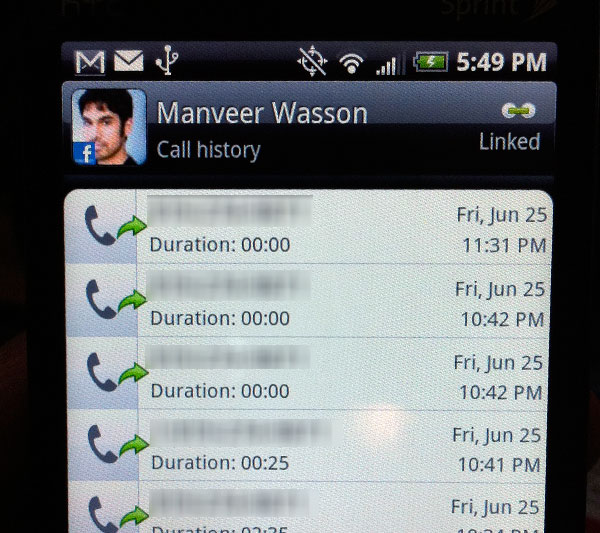The Sprint HTC EVO 4G Review
by Anand Lal Shimpi on June 28, 2010 6:04 PM ESTThe Basics
The EVO 4G currently ships with Android 2.1, although sometime before the end of the year it should get 2.2. Layered on top of Android is a set of HTC developed apps, widgets and UI modifications called Sense. As a whole HTC’s Sense makes Android a much more polished experience and is generally a positive thing. The downside is that it takes HTC longer to bring Android updates to its phones as it has to not only port the updated Android code but also make sure that Sense works with it as well. I’ve already looked at Sense in my Incredible review and talked about Android in my Nexus One review. What follows here is a brief refresher as well as an update on some things I didn’t touch last time around.
The lock screen is different but no better or worse than what I’ve seen on other Android phones like the Nexus One. Instead of swiping left to unlock, you swipe down. If your phone is locked and you get a call you just swipe down to answer and swipe up to decline.
When locked any incoming text messages appear with a preview at the bottom of the screen. This is in addition to the usual notifications up top which I’m happy to say I’ve finally gotten used to and definitely appreciate above and beyond what Apple does in iOS. I still have a fondness for webOS’ notification system but until we see a resurgence of Palm under HP management I’ll have to count them out of the smartphone wars.
The main home screen has a calendar/weather widget and icons for Messages, People (Contacts), Mail, the Android Market, the Camera and Voicemail. You can add your own icons by hitting the menu button and selecting the Add to Home option.

There are a total of 7 home screens that you can configure on the phone. Three to the left and three to the right of the main screen I just described. The default EVO 4G skin has a page with an MP3 player widget as well as a bunch of Sprint apps, a page with a Bookmarks widget for frequently accessed websites and one more with a Friend Stream widget that combines your Facebook and Twitter updates into a single stream of other peoples’ lives. The other three home screens include a calendar, Google search bar and widgets to turn off things like 4G, WiFi, Bluetooth and GPS.

The quick access to turning off 4G and WiFi is pretty nice, although in practice the 4G toggle didn’t get as much use as I thought it would.
The favorites widget automatically populates itself with frequently dialed contacts. If you supply your Facebook login information it will also indicate if your contact has updated their Facebook page. Unfortunately trying to view a Facebook profile from a contact’s info page won’t launch Facebook’s Android app but instead just load the mobile version of Facebook in the browser.
Cloud Integration
Like all other Android devices, the EVO 4G integrates with the cloud very well assuming you actively use a couple of key services: Google apps and Facebook. If you supply your login information to those services (you can also add Flickr and Twitter) pretty much every aspect of your phone will automatically integrate itself into your life before you can even think of the word sync.
Contacts will automatically get pulled from your Google contacts and Facebook friends list. Email addresses, phone numbers, addresses, photos, everything all get integrated onto your phone. If anyone changes their contact information in Facebook it’ll get updated on your phone. If you update a contact in Google the same will happen on your phone. It’s very nice. If you don’t use those services then the EVO works more like a regular phone but without good supplied desktop sync software.
The cloud integration is ridiculously convenient. It’s useful enough that it makes going to most other devices feel ancient. Even if you don’t have your life in the cloud, stepping foot into the Android world is generally enough to make you want to change.
Organization by Person
Once you’re all synced up with the cloud Android truly behaves like a Google product: it just works on organizing data. Here are all of the things you can do when you’re looking at a single contact on the EVO 4G (or any other HTC Sense enabled device):
- View Contact Information including available personal information from Facebook
- View all SMSes exchanged with the contact
- View all emails exchanged with the contact
- View latest Facebook and Flickr updates and albums
- View a log of all calls between you and the contact (you can also clear the call log history)
The functionality itself is above and beyond anything Apple offers, but it gets better. There’s full customization available on anything I mentioned above.
Want to see only the past day worth of Facebook updates for the contact? That’s configurable. Want to see the past 30 days of Facebook updates? You can set that as well, all on a contact by contact basis.

You can also do typical cellphone stuff to each contact. You can opt to send the contact straight to voicemail whenever they call or choose specific ringtones. Linking a contact to their Facebook profile is particularly helpful since we’re vain creatures and tend to share our birthdate with our FB friends. You now have a quick way of figuring out when someone’s birthday is just by pulling up the contacts in your phone.
If this all sounds like stuff you’d never want to deal with, you don’t have to. The EVO 4G still works like a normal smartphone. The flexibility is simply a selling point of Android.










97 Comments
View All Comments
JimmiG - Monday, June 28, 2010 - link
Amazing how expensive plans are over there compared to where I live.I have unlimited data at 6Mb/s and make calls for the equivalent of 5 cents a minute. That costs $26 a month (plus the cost for any calls or texts). There are cheaper alternatives if you only need 1GB or 5GB of data month. Sure, there's no subsidized phone included, but I just bought an unlocked HTC Desire (~Nexus One), it costs about the same as a high-end netbook.
Over 24 months I pay maybe half of the quoted prices, one-time cost of phone included.
chriscusano - Monday, June 28, 2010 - link
Where is there?DigitalFreak - Monday, June 28, 2010 - link
Considering he's getting 6Mb/s, I'd have to assume somewhere in Europe. :-)JimmiG - Thursday, July 1, 2010 - link
I'm in Sweden which is why I was even more surprised. Everything tends to be more expensive here, not cheaper.Another operator offers 1GB/month at 6Mb/s for $9 a month and 5GB/month at 10Mb/s for $16 a month. But I choose unlimited data over the higher speed since stuff like HD video is kind of pointless on a 3.7" screen.
Of course you don't always get those speeds. Some 3G areas, especially in rural areas, don't support HSDPA so you only get 384Kb/s. But most built-up areas have at least 2Mb speeds and the entire city where I live offers the full bandwidth.
strikeback03 - Tuesday, June 29, 2010 - link
So what would it cost for about 1500 minutes, 6000 SMS, and 200 MMS?Gamingphreek - Monday, June 28, 2010 - link
Anand,I have found SIGNIFICANT performance and battery improvements in using LauncherPro by Federico Carnales on my HTC Hero <www.launcherpro.com>. I would be interested to hear if you notice the same thing.
Additionally, while it is only for root users, Autokiller is a terrific application for modifying the Android's preset memory limits.
Finally, regarding internet use, Dolphin Browser HD 2 is head and shoulders above the stock browser in every aspect. You may consider trying and seeing if that makes a difference in the browsing tests.
Great review regardless, but as a long time Android user, I have found these to make a significant positive impact on my overall experience with the device.
I know adding different applications to review can get out of hand very quickly, but is there any chance we might hear about your experience with some of these aforementioned applications?
Thanks,
-Kevin
chriscusano - Monday, June 28, 2010 - link
Hey great thoughts. Well I don't have an android myself, but maybe you guys might want to consider writing up an article (after official 2.2 release I'm thinking) with a phone "fully optimized" using some of the best (and cheapeast/free) apps out there. I think a phone with these apps will be sigificantly better than a stock phone. It's *almost* like comparing an oem computer out of the box to a customized computer (with a few performance tweaks). All serious computer users as well have their own customized setups that make their experience much, much better than a standard one (choice of web browser w/ addons/extensions, cutomized start bar, useful desktop gadgets, etc). Truly the experience can be totally different when things are customized. I'd image the same is the case with a phone like this.Also, man I've been looking for some VOIP 4G tests. Help me out guys! I may try to downsize to one internet carrier for home and phone but my major concern is I NEED VOIP for work. Can 4G cut it if the signal strength is strong (from a static location)? Does tethering via USB to the computer affect internet speeds? If so, how is VOIP from the computer when tethering via USB? Anyone? Anand ? :)
-Chris
Gamingphreek - Tuesday, June 29, 2010 - link
I have an HTC Hero, so I'll have to run all the tests over before I do it with the apps, but I would be more than happy to run a couple tests and send in a short little article for Anand's consideration. I can post it in the forums too just for general knowledge.My undergraduate research prior to my graduation this past May was on the Android OS (More specifically how secure it was from an IT Security perspective).
Impulses - Tuesday, June 29, 2010 - link
There's a ton of things you can do to optimize battery life, from alternate launchers, to custom ROMs, to simply configuring the stock sync settings for the various accounts. Something Anand made no mention of, and it's one of the more obvious tweaks, the stock settings are actually pretty poor if you wanna preserve battery life but they're easy to change from 2-4 hours to 8 hours or daily or w/e.The latter alone made a difference for me, but some of the custom ROMs and such make a very very noticeable difference as well. It's really quite amazing what some of the user devs come up with, it puts Google/HTC's stock builds to shame. I've no idea if the iPhone jailbreak community delves into that kind of low-level optimization but the stuff they're doing on Android's end is awesome.
misaki - Monday, June 28, 2010 - link
Froyo is now getting rolled out officially, so I hope you guys will include it in your browsing comparisons since the speed gains are so drastic ;)